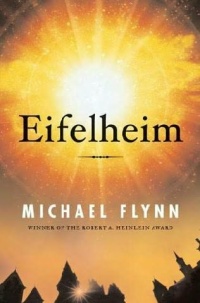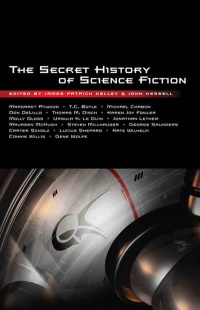 She stared at him, her head spinning. Aliens? she thought. In medieval Germany? It was fantastic, unbelievable.
She stared at him, her head spinning. Aliens? she thought. In medieval Germany? It was fantastic, unbelievable.
Yes, aliens in medieval Germany. That’s the general premise of Eifelheim (2006), Michael Flynn’s unusual take on extraterrestrial contact set in the fourteenth century when the Black Death was ravaging Europe. This is a moderately strong novel with a refreshing twist on the first contact theme, and it comes across as a mature and balanced look at the intersection of two types of minds that we might consider alien: those of the actual aliens, and those of our medieval ancestors. Actually, in some ways the extraterrestrials are easier for our modern sensibilities to relate to; this is partly because they are closer to us in terms of science and technology, and partly because Flynn does a good job of showing just how different medieval thinking was from that of today.
The story is told in two different time frames. One is that of Germany circa 1348, when the alien Krenken, visiting Earth during a scientific expedition, become stranded and find themselves increasingly entangled in the lives of nearby villagers. The other is the present day, when two people, one a physicist and the other a historian, each working on a particular problem in their own field, realize that their two problems intersect, and stumble upon the truth about an alien visit centuries earlier.
The “Now” chapters tell the story of historian Tom Schwoerin and his physicist girlfriend Sharon Nagy. Tom specializes in cliology, which is essentially what Isaac Asimov called “psychohistory” — the rigorous mathematical study of history that provides understanding and predictability of large-scale social trends. Tom encounters a mystery: cliology tells him that cities and towns distribute themselves in a certain pattern based on population, natural resources, terrain, and so forth. However, the village of Eifelheim presents an inexplicable gap in his maps of medieval Germany. It was suddenly abandoned and never repopulated, when all his theories predict that it was a location that should have remained in use. This problem consumes Tom and he won’t let it go. Sharon works in the heady realm of physics and cosmology. She theorizes on the topology of space-time, particularly in the framework of something called Janatpour space. As she pushes her theories further and further, she sees the possibility of instantaneous travel through what she calls “hypospace.” Her ideas are unconventional and her department chairman ridicules them, but Sharon knows she’s on to something. As Tom and Sharon vent their frustrations and bounce ideas off each other, they begin to see a connection between their respective projects…. a connection that will change the world. These “Now” chapters are taken from Flynn’s original “Eifelheim” novella from 1986, and actually make up only perhaps 20% of the present novel. By far, the majority of the story takes place in the past, describing the events of the alien contact itself.
The relationship between the stranded aliens and the Eifelheim villagers is a strained one. The Krenken are humanoid (two arms, two legs, bipedal, etc.) but have an insectoid, grasshopper-like appearance which causes some people to take them, literally, for demons. But the general reaction of the villagers is shaped largely by Eifelheim’s priest, Dietrich, who takes his mandate of charity very seriously. He views the Krenken as men from a distant place, perhaps from China or somewhere even further away, and convinces the local Lord that the right thing is to aid them in their time of need, rather than to shun them. And as it turns out, their need is very great, for they are, in fact, dying from lack of an essential nutrient not found on Earth. A further tragic complication is added when the Black Death sweeps into the area.
In an interview I read, Flynn said he wanted to avoid the common stereotype that “medieval” means “primitive,” and he succeeded at that; there is little in this book that could be called “stereotypical.” The fourteenth century is portrayed with realistic complexity. There is the kind of small-minded superstition we would expect, yes, but Flynn also emphasizes the degree to which logic and reason were prized, even during the so-called Dark Ages. There is the ugly side of religion, the torture of “heretics” and the strife between various sects, yes, but there is also the simple dedication of the villagers to uphold their ideals of charity, even with respect to creatures who are frighteningly different. And, contrary to what you might think, Flynn does not give us the common scenario of the “primitive” humans learning at the feet of the advanced aliens. The interaction is a two-way street, with the two peoples exchanging philosophy, political ideas, and spiritual concepts. In fact, some of the Krenken actually convert to Christianity before the end.
It’s obvious that the book was meticulously researched, and the level of historical detail is impressive. I was pleased to recognize some of the information presented about the Black Death, remembering it from a documentary I saw last year. Flynn kindly assists the reader at the end of the book with both Historical Notes and Physics Notes. And at the front there is even a map of the area (very useful) and a list of characters (not very useful in my opinion). This was an enjoyable read from a capable writer, and I’m happy to recommend it.















The new look is great, Bill. Up on the right hand side of the screen, just almost directly to the right of the top of the main window here, does anyone else see a little tiny smiley face?
Bill, I was wondering if you’ve read The High Crusade (Anderson) and, if so, how this book compares.
Sorry Steve, no I haven’t read the Anderson book. It’s fantasy, isn’t it? Or am I thinking of another book?
That’s me, smiling at my visitors. 🙂
Actually, no, I didn’t notice that until you pointed it out.
I keep hearing good things about this book. I will put it on my reading list.
His next book was The January Dancer. Reviews have not been as good for it.
I’ll have a copy of TJD soon, so we’ll see how that goes.